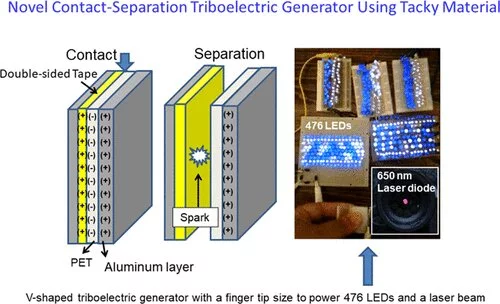With an ability to turn friction into small amounts of electricity, triboelectric generators may one day be used in clothes that turn movement into power, in battery-free brain implants, and a host of other scenarios. Scientists working on cheap and easy versions of these tiny generators have landed upon a design that makes use of store-bought double-sided tape, and which they say can perform on par with more complex versions when it comes to producing electricity.
We’ve seen many versions of triboelectric generators over the years that work on the premise that certain materials become electrically charged when rubbed against one another, such as a balloon and your hair. According to the authors of this new study, designs so far have involved complex arrangements of expensive parts, and have also had a limited output in terms of power.
Led by Gang Wang from the University of Alabama, the scientists have now made inroads on a less complicated version. The researchers' triboelectric generator builds on earlier research that indicated these systems can be made of tape, plastic and metal, but they piece these components together in a way that brings their performance up to that of more complex and expensive versions.
The design comprises store-bought double-sided tape and plastic film, sandwiched between thin plates of aluminum. Pressing the layers together momentarily and disconnecting them causes a spark to form, with the amount of pressure applied directly influencing the amount of power generated.

A version of the generator featuring two electrodes was used to produce a power density of 169.6 W per square meter (10.7 sq ft), which the team says is 47% higher than previous designs. In a round of experiments, the team used the generator to light up an array of 400 LEDs by simply pressing on its layers.
Powering LEDs or other small electronics is one possible use case for triboelectric generators, but there are many more. The list includes wooden floors that harvest energy from foot traffic, hearing aids that power themselves, touchscreens that generate electricity when you use them, and forest sensors powered by swaying tree branches. In making one of these generators with the help of store-bought items, the scientists have thrown a simpler, low-cost approach into the mix.
The research was published in the journal ACS Omega.
Source: American Chemical Society




